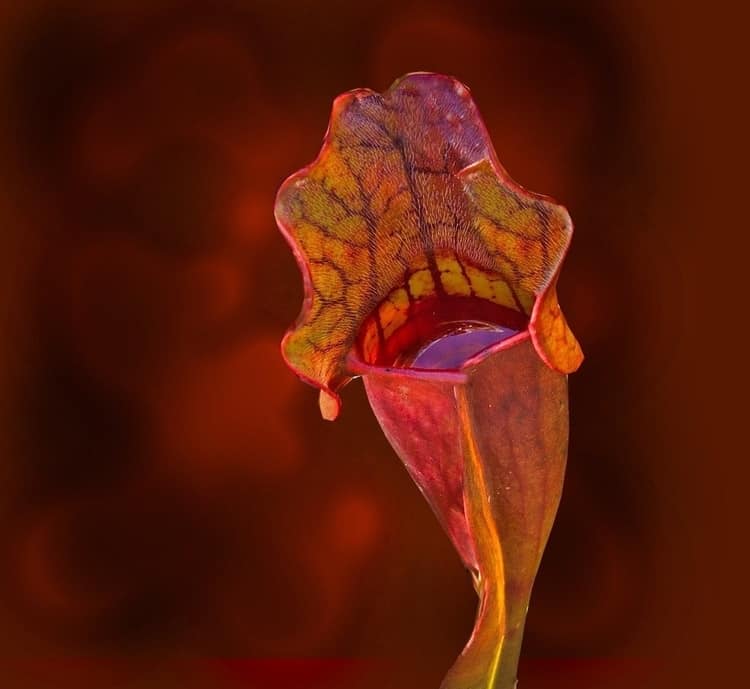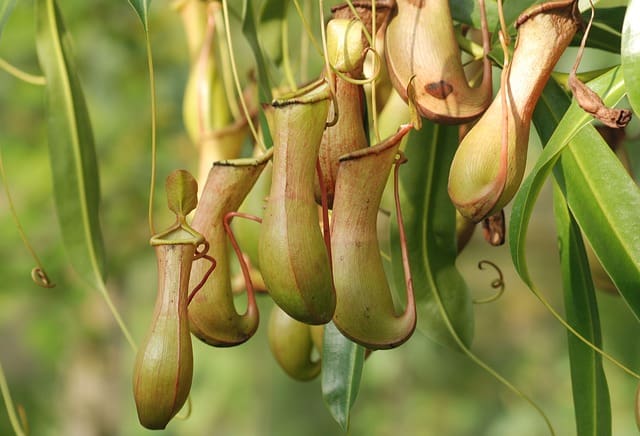Considering that the pitchers or your carnivorous plants are shaped like something perfectly equipped to hold liquid, you might wonder if you are supposed to fill them with water. The answer depends on the species.
While most pitcher plants like Nepenthes produce their own digestive fluids, others are dependant on collecting rainwater and might need human help to fill up their pitchers with water. The only plant that needs to collect rainwater in its pitchers is Sarracenia Purpurea and their hybrids.
In this guide, you will learn how to fill a pitcher plant with water (when it is appropriate). Also, I will show you how to trigger your plant to produce its own fluids.
When to Fill Pitcher Plants With Water?
Especially when you keep your plants indoors and not exposed to the rain, it seems logical to give them what they are supposedly missing away from their natural habitat. But should you do that? Is it good for your plants when you fill their pitchers with water?
Pitcher plants have fluids in their pitchers. Some collect rainwater; others produce their own fluids. But, the fluids should always be present to capture and digest insects.
The Sarracenia Purpurea collects water from rainfall in its pitchers. The insects that fall into the pitchers, like for example flies, spiders, or ants, then drown in the water before they are digested. It also needs rainwater to provide a fitting habitat for the bacteria living in the pitchers.
When a Sarracenia Purpurea does not have access to enough rainwater, it is recommended to add pure water inside the pitchers. You should never add water to other pitcher plants, as they produce their own fluids.

There are no other species that contain rainwater in their pitchers. Carnivorous plants like Nepenthes, venus fly traps, or most subspecies of Sarracenia, like the Flava or Oreophila, produce their own digestive enzymes as well as the often acidic digestive fluids. Sarracenia Purpurea, though, is dependent on hosting diverse organisms in their pitcher that dissolve their prey for them.
Taller species of Sarracenia even tend to tip over when they are filled with water since they are not made to hold such a large amount of fluids – you might have noticed that the moist puddle at the bottom of their pitchers is usually quite shallow. Adding water yourself would even damage them. Most species of pitcher plants protect themselves from rain by a hood on top of the pitcher that, aside from not letting rain get in, also keep the trapped insects from escaping.
The hoods on top of a pitcher of the Sarracenia Purpurea, conversely, are angled in such a way that allows water from rainfalls to collect inside the pitcher. Since they do not properly function as hoods in the literal sense, they are sometimes referred to as lips.
If your pitcher plant is a hybrid and you are unsure whether to add water, you should compare the size and shape of its pitchers and hoods with those of Sarracenia Purpurea versus other species. This will give you an idea of how its digestion works and if it is grown to let in rainwater.
When to Add Water to a Pitcher Plant?
Add water to the pitchers of your Sarracenia Purpurea when you get the impression that it is running low in fluid since it needs this to keep the bacteria that live in its pitchers happy and thriving.
Fill the pitchers of Sarracenia purpurea only when the fluid level is low. Never fill your plants up to more than 1/3 of the total height of their pitcher. Any more than that would be too much and the pitcher would fall over.
Better start with a smaller amount of water and observe your Sarracenia when it feeds – if you get the impression that it does not manage to properly dissolve its prey, you can always add more water.
Sarracenia Purpurea: Which Type of Water Should You Add?
Carnivorous plants are quite sensitive when it comes to what kind of water is good for them. Do not make the mistake of simply giving them tap water, even though most of your other plants are happy enough with this!
Tap water contains salt and chemicals (so-called TDS, totally dissolved solids) which are harmless to humans and most house plants but might damage your pitcher plant by causing leave burning, wilting, or root burn, and eventually lead to the death of your carnivorous plant.
The degree of TDS water contains is measured in parts per million (PPM). Pitcher plants can tolerate a PPM rate between 50 and 140, but unfortunately, although the PPM rates for tap water vary widely with regards to location, they are mostly found to be between 100 and 400 PPM. This is simply too much of a risk to expose your plants to. If you are unsure about the quality of your tap water, you can order a cheap PPM meter online. The pH – the measure of acidity/alkalinity – of the water you give to your pitcher plants should be neutral at around 7.0, which you can test with pH strips available online or in aquarium or pool supply stores.
Since Sarracenia has evolved in nutrient-deficient soils, it is adapted to draw minerals from its prey instead of its soil, therefore it would be overwhelmed by water containing minerals. Aside from tap water, this also includes bottled water and filtered water. For this reason, you also should not use fertilizer on carnivorous plants.
There are three main kinds of water that are compatible with pitcher plants: rainwater, distilled water, and water resulting from a reverse osmosis process.
RAINWATER can be collected for example in buckets or rain barrels. Either place them on your balcony or garden or directly beneath the gutters coming from the drain. This, of course, might be difficult if you live in a place where it does not rain a lot, or in the case that you are renting an apartment which does not give you access to a garden or balcony.
When you have enough containers to store rainwater for a long time, make sure that these containers are opaque because light getting in would encourage the growth of algae. There are even UV-resistant containers that are specially made not age and crack in the sunlight.
All in all, using rainwater is better for outdoor plants than for indoor plants, though. No matter how much care you take to store it correctly, it is always possible that rainwater is contaminated by algae, fungi, or bacteria. Plants that are kept outside are included in an ecosystem that works at keeping potential outbreaks at bay, whereas indoor plants lack this ecosystem. If you do not want to risk this, the following methods might be better for you.
DISTILLED WATER can be purchased at the store, but you can also get a basic household distiller and distill it yourself. In a distillation unit, water is first heated to a boiling point. Thus, the water evaporates, leaving most of the contaminants behind. When the vapor is cooled down again, it results in distilled water. Since distillation only produces a few gallons of water per day, this is best for people that do not have too many plants.
REVERSE OSMOSIS systems force unfiltered water through a semipermeable membrane that allows water molecules to flow through but blocks contaminants. Water automatically flows from the more concentrated side of the membrane, which contains more contaminants, to the less concentrated side. This process removes about 99% of bacteria, chlorine, and other harmful substances in the water.
How Would Adding Water Help the Plant?
Bacteria and microbes live there and they help the Sarracenia to digest its prey since this species does not produce efficient enzymes to aid in digestion. The pitcher fluid acts as the organism which these helpful species occupy. Adding water thus creates this habitat necessary for your carnivorous plant to be able to take nutrients from the insects that it traps.
What to Do There if There No Liquid in a Pitcher Plant?
When you notice that there is no liquid inside the pitcher of a plant that usually produces its digestive fluid itself, this can be a sign that the humidity in the room is too low. In this case, you might consider growing the plant in a greenhouse – if you do not have the outdoor space for this, there are humidifiers available that will fit on your windowsill or a table.
Pitcher plants usually grow in pretty humid climates. They need to take humidity from the air and soil to produce liquids inside their pitchers. The digestive fluid is secreted into their pitcher by the same glands that are also evolved to take the nutrients from the dissolved prey.

Digestive fluid largely contains two enzymes: Basic chitinase, which is able to disintegrate the hard exoskeletons of insects, and purple acid phosphatase, which is what makes it possible for the plant to absorb the nutrients.
Do you want to learn how to feed your Pitcher plant? This guide can help you learn which bugs to employ and how to do it: What To Feed a Pitcher Plant: A Comprehensive List (Plus Feeding Tips)
Also, make sure to read my complete guide to Pitcher plant care.


